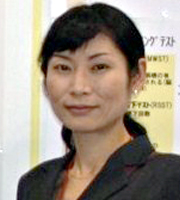I carried out research on the properties of niylon6 microfiber and a super microfiber and studied the feelings of these fibers on human skin. The mechanical and sorption properties of the fiber samples with cross-section diameter of 9 and 2 µm were analyzed, and the properties of these fibers were found to be different from those of normal fine fibers. In addition, fabrics were manufactured using these fibers having different cross sectional diameters. The tactile sensations produced by these fabrics were evaluated by performing a feeling test. The results showed that the microfiber fabrics produced a distinctive tactile sensation.
In the present study, a hygiene mask is being developed; the aim of this study is to carry out a quantitative assessment of the influence of different types of designs and materials used to manufacture commercially available masks that prevent the spread of hay fever on wearing comfort. The mechanical properties, thermal properties, airflow characteristics, pollen collection capabilities, and sensory evaluations of the masks were evaluated in terms of the fit of the mask, temperature and humidity between the mask and the face, air flow behavior surrounding the mask, and wearing comfort.
In addition, as a developmental application of the study on the mask used to prevent the spread of hay fever, I will propose a moisturizing mask that can be used by elderly persons to prevent dryness of the mouth. It is important to invest effort in the prevention of the spread of influenza and viral infection among the aged population. In particular, elderly persons who live in welfare facilities for the aged are found to keep their mouth open because they have weak temporomandibular joints. In this scenario, many problems have been encountered with regard to ensuring protection against viral infection. Therefore, a mask that is most appropriate for such situations is being developed.
With regard to the relationship between the physical properties of microfibers and the feelings of these microfibers on human skin and the measurements and evaluation of the hygiene mask, I intend to develop a mask and a type of thread that would provide comfort in the near future. I also intend to develop textile products in academic manufacturing area.
Profile

Mika MORISHIMA
- Research Area:
- Textile Engineering
- Keywords:
- Textile Production, Microfiber, Super microfiber, Comfort evaluation
- Contact:
- 3-15-1 Tokida, Ueda-shi, Nagano-ken
Japan 386-8567
E-mail: morisima[at-mark]shinshu-u.ac.jp
- M.Morishima, A.Morikawa, H.Gocho, E.Jojima and Y.Shimizu, “Sorption and diffusion behavior of water for Nylon-6 fibers of various diameters", J. Society of Fiber Science and Technology, Japan, 57, pp.69-74(2001)
- M.Morishima, A.Morikawa, Y.Shimizu, M.Takatera, H.Gocho, E.Jojima, “Evaluation of Tactile Sensation for Fabrics of Various Fiber Fineness", Kansei Engineering International, 2 (4), pp.27-32 (2001)
- M.Morishima, A.Morikawa, H.Gocho, E.Jojima, “Mechanical Property of Super Micro Nylon6 Fiber with Various Diameters", J. Society of Fiber Science and Technology, Japan, 57, pp.368-374 (2001)
- M.Morishima, A.Morikawa, H.Gocho, E.Jojima and Y.Shimizu, “Mechanical Property of Nylon6 Fiber with Various Diameters in Standard Wet and Water-Immersed Conditions", J. Society of Fiber Science and Technology, Japan, 58, pp.294-298(2002)
- M.Morishima, S.Wang, H.Kubo, T.Uozumi, “Analysis of the Kansei evaluation process on 3D shape models for development of object-design-system", J.Japan Society of Kansei Engineering, 6, pp.11-16(2003)
- N.Yabuki, L.Li, S.Wang, M.Morishima, H.Kubo, T.Uozumi, “A Mechanism of KANSEI(sensitivity) Evaluation of 3D Shape Primitives for Development of an Aesthetics Design Support System of Civil Infrastructures", J. Civil Engineering Information Processing System, 12, pp.265-272(2003)
- M. Morishima, M.Ogisu and N.Miyamoto, “Development and Evaluation of Dynamic Deformation Behavior Measurement System of a Mask for Hay Fever", J. Japan Society of Kansei Engineering, 15, pp.43-46(2006)
- M.Morishima, “A STUDY ON FIT ABILITY OF 2-D GAUZE MASKS FOR HAY FEVER", J. Japan Society of Kansei Engineering 19, pp.537-543(2008)
- M.Morishima, “FIT ABILITY OF A DIFFERENT MATERIAL AND SHAPE OF MASKS FOR HAY FEVER", J. Japan Society of Kansei engineering, 242, pp.1011-1020(2009)
- H.Kimura, M.Morishima, T.Nishioka, L.Wakako, Y.Matsumoto, “Stretch Properties of Cotton Hollow Yarns Made by Hybrid Open-End Rotor Spinning Frame", J.Textile Engineering, 55(6), pp.187-192(2009)
- M.Morishima, H.Kanai, T.Nishioka, T.Inoue, T.Nishimatsu, “Influence of Sportswear Shape on Dressing Motion of Dummy Elderly Person", J.Textile Engineering, 56(3), pp.47-53(2010)
- M.Morishima, H.Kanai, H.Kimura, T.Matsumoka, T.Nishioka, T.Nishimatsu,"fluence of Sportswear Shape on Dressing Motion and Muscle Activity in Dummy Elderly Persons", J.Textile Engineering,, 57 (2), pp.51-59(2011)
- H.Kanai, M.Morishima, K.Nasu, T.Nishimatsu, K.Shibata T.Matsuoka, “Identification of Principal Factors of Fabric Aesthetics by the Evaluation from Experts on Textiles and from Untrained Consumers", Text. Res. J., published online (2011)
Research Statement
My goal
I have previously investigated the relationship between the properties of microfiber and the feeling of the microfiber on human skin. I have also measured and evaluated the comfort level associated with the use of hygiene masks. In light of these experiences and achievements, I believe that my work will help in bringing about improvements in the textile products used for manufacturing hygiene masks in the health sector, which has a great impact on the quality of life. I believe that the practical implementation of the results obtained in my academic studies during product manufacturing would help in bringing about improvements in textile products and would increase our knowledge of textile materials, fiber, and spinning and weaving process.
In addition to these research activities, I am actively involved in educational activities that would enable students to develop comprehension skills and systematic methods of self learning and also allow them to apply their ideas to daily-life activities, and for the benefit of society in manufacturing.
My goal is that at the time of their graduation, the students appreciate the usefulness of their studies at Shinshu University. In order to achieve these goals, I am devoting a lot of positive effort into education and research.